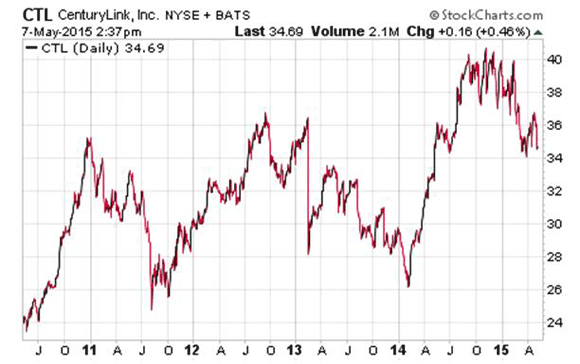Dividend Payout Ratio Secrets
Sounds boring, doesn’t it?
Look…
There’s no way to convince you the dividend payout ratio packs the excitement of a classic James Bond movie.
(I have a soft spot for Casino Royale.)
But here’s the deal.
If a James Bond movie villain put a gun to your head, and forced you to choose just one piece of information…
Just one piece of data from all the financial data out there to pick a great dividend stock…
You’d be smart to pick the dividend payout ratio. It could save your life.
The dividend payout ratio can help you find the best dividend paying stocks, and protect you from a lot of trouble.
You can learn a lot about the dividend stocks you’re thinking about buying when you know how to use the dividend payout ratio.
The good news… it’s straightforward stuff. Common sense.
Dividend Payout Ratio Basics
Can the company afford to pay a dividend?
And can it afford to keep on paying it? Maybe even be able to afford to grow the dividend in the future?
These are the life and death questions the dividend payout ratio will help you answer.
Lots of companies plow money into dividends when they should use the money for something else.
It’s like the guy who leases a BMW 740i when he should repair his roof.
The guy with the BMW wants to show off, or make himself feel good.
Well, the company wants to show off too. It wants to catch the attention of investors with a high dividend.
It might be hoping to lure in new investors. Maybe it figures it can give its sagging stock price a shot in the arm with a high dividend.
You see what’s going on here? Some slick window dressing to try and cover up a problem.
And the problem is usually tied to revenue.
As an investor, you want to see revenue coming in to keep the cash flow healthy.
The Dividend Payout Ratio and Cash Flow Dance Together
It’s important to have strong cash flow.
Why?
The company needs to have enough cash on hand to cover all of its expenses and to pay the dividend.
You can check the cash flow statement in the financials to see what’s happening.
And keep in mind, there’s a difference between the income statement and the cash flow statement.
The income statement tells you if the company is making money.
The cash flow statement shows you what’s happening with money coming in and going out. It changes over time. (Actually, it changes constantly, just like the balance in your personal checking account.)
Take a look at the bottom line, and you’ll see the net increase or decrease for cash during a set period, usually the most recent quarter.
You’ll see if the cash flow for operating activities, investing activities, and financing activities is up or down.
The stronger the cash flow, the safer the dividend. Watch out for wild swings. If there is a wild swing in one of these three categories… operating activities, investing activities, and financing activities… find out why.
For instance, cash flow might be up quarter to quarter for operating and financing but down for investing.
This might mean that a company has bought new equipment or a new building. The cash it keeps on hand for investing goes down as a result.
When it sells equipment or a building, cash flow goes up.
Here’s something else you might want to take a look at. See how cash flow grows.
Sometimes, it looks like cash flow grows, but in reality it doesn’t.
No, this isn’t slick, shady accounting. The numbers are legit, but they reveal something dangerous…
This is something that should drive you away if you’re thinking about investing in the stock.
A company can actually go out and borrow money and use this money to pay a dividend.
You can discover this when you check out the financing activities part of the cash flow statement.
It’s kind of low rent, borrowing money to pay a dividend. A little desperate.
But it happens, and a lot of investors looking for stocks with the best dividends never see it.
It’s just like a guy borrowing money from a friend so he can take a date out for a fancy dinner to try and impress her.
Why would a company do this?
Because it’s in trouble. Paying the dividend becomes a wobbly Hail Mary pass.
Want to see a company in trouble that is struggling to pay a dividend?
Check out CenturyLink $CTL.
An 83.7% dividend payout ratio, and this is a technology business that needs to be investing in research and development.
It has the infrastructure it needs to maintain and update.
CenturyLink used to be a model citizen. It was an S&P Dividend Aristocrat until it couldn’t grow its dividend anymore.
Take a look at what happened to the stock in early 2013… a dividend investor’s nightmare…

Yes… the stock recovered. But it’s not exactly in good health. Not with an 83.7% dividend payout ratio.
When CenturyLink revealed its 2015 first quarter performance, it reported revenues were down. So was operating cash flow.
Don’t expect CenturyLink to get back to where it was in the fall of 2014 anytime soon.
This stock is a perfect example of the trouble you can get into when you run into a high dividend payout ratio combined with cash flow that’s heading south.
I’ve mentioned CenturyLink before. It was the stock I looked at to reveal how you can try to predict the death of a dividend aristocrat.
And since I wrote about “The Stink Of The Link” back in the fall…
The stock price has skidded 10%.
How To Know You’ve Got A Good Dividend Payout Ratio
So, you might be wondering…
“What should the dividend payout ratio be? What kind of number should I be looking for?
Take a look at the best dividend stocks and you’ll get an idea.
The S&P 500 Dividend Aristocrats are where you’ll find some of best.
Keep in mind these are big, mature companies with solid balance sheets, plenty of money, and no need to play games to spruce up their dividend payments.
That’s why the dividend payout ratios tend to be fairly low.
Other stocks behave differently.
Some of the best small cap dividend stocks have a higher dividend.
REITs, the Real Estate Investment Trusts, always have a high dividend payout ratio. That’s because of tax laws.
But REITs are the only exception to the rule.
Break the rule, invest in a dividend stock with a dividend payout ratio that’s more than 50%, maybe 60% if there are special circumstances and you’re feeling unusually charitable, and you’re playing with fire.
The Simple Number That Tells You So Much
There you go.
One simple number that cracks open the window on a company’s inner workings. Your behind the scenes glimpse into what’s happening to pay the dividend.
Is this the kind of company that behaves like the guy who won’t spend money to fix his roof and leases a BMW 740i, or is it taking care of business?
Not that there’s anything wrong with a 740i.
So why not invest in safe stocks that pay you enough dividends to make the car payments?
Regards,
Michael Jennings
Note: Michael Jennings writes and edits DividendStocksResearch.com. Sign up for our free dividend reports and dividend newsletter at https://www.dividendstocksresearch.com/free-sign-up. We’ll show you how to create regular income by investing in dividend stocks, easily, step-by-step.
Category: Dividend Basics





